Hovawart Dog Breed Information
The Hovawart, a breed known for its dual role as a working dog and a family pet, has a rich history that attracts those interested in dogs. It comes from Germany’s Black Forest and has a heritage dating back to the Middle Ages, where its forebears were valued guards. Nowadays, this breed is sought after for its even temperament and good health, making it a top pick for those looking for a loyal and versatile dog.
The Hovawart’s smarts and physical strength mean owners must understand how to meet its exercise and training requirements, which are vital for a successful partnership. In considering the Hovawart’s place in contemporary dog ownership, it’s clear that its age-old charm still resonates. Its ability to adapt to various roles, from family protector to affectionate companion, ensures its popularity.
However, owning a Hovawart is a commitment to meeting its needs for mental stimulation and physical activity to ensure a well-behaved and contented pet.
Key Takeaways
- Hovawart dogs hail from Germany’s Black Forest.
- They serve as both protective guardians and loving pets.
- Mental and physical stimulation keeps them happy and well-behaved.
The Hovawart, a breed of medieval German origin, excels in security and companionship. This dog’s intelligence and strength demand owners to provide ample exercise and consistent training. Known for its versatility, the Hovawart remains a favored breed in modern dog ownership, owing to its ability to quickly fulfill various roles. Commitment to this breed involves meeting their engagement and activity needs, fostering a balanced and satisfied companion.
Quick Facts
The Hovawart is a sizeable dog breed with a muscular build, generally tipping the scales at 65-90 pounds and reaching a height of 23-28 inches. These dogs have a lifespan of 10 to 14 years. They hail from Germany and are officially recognized by the German Kennel Club. Although not as common in the United States, they are part of the AKC’s Foundation Stock Service, indicating their special status among dog breeds.
With their striking looks, Hovawarts come in three coat colors: blonde, black, or black with tan or gold accents. Their thick fur needs frequent brushing to manage shedding. Known for their watchful nature, Hovawarts can be wary around strangers, making early and consistent training crucial. They thrive best in spacious environments where they can stay active and mentally engaged. Prospective owners should be aware of certain health conditions prevalent in the breed, like hip dysplasia, hypothyroidism, and degenerative myelopathy.
Hovawart Dog Breed Pictures
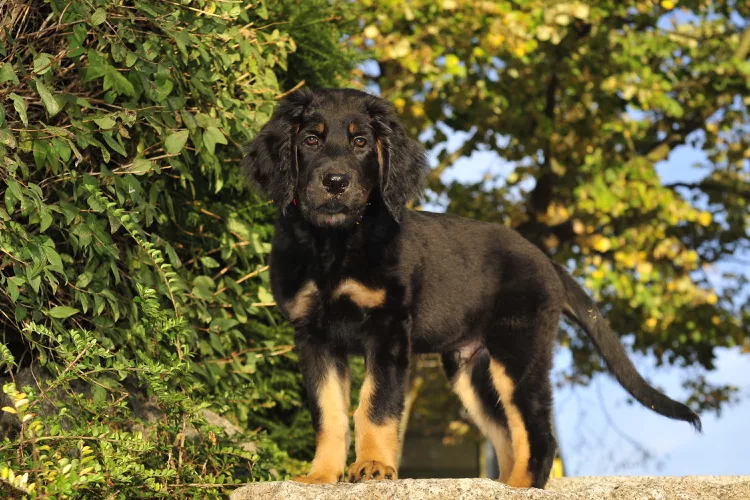
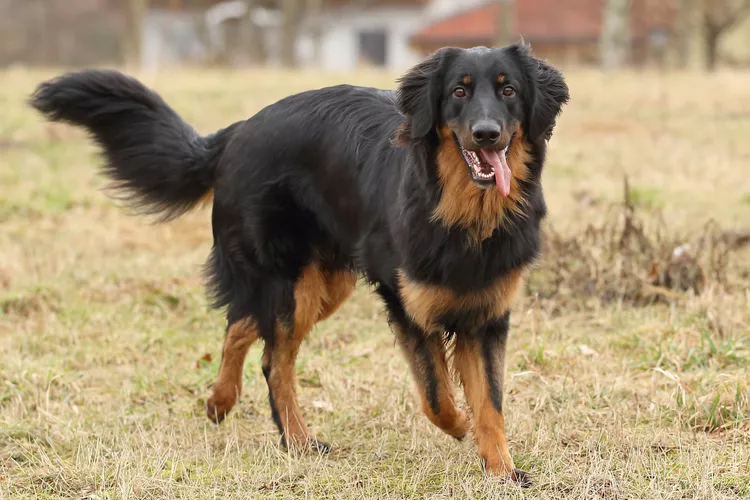
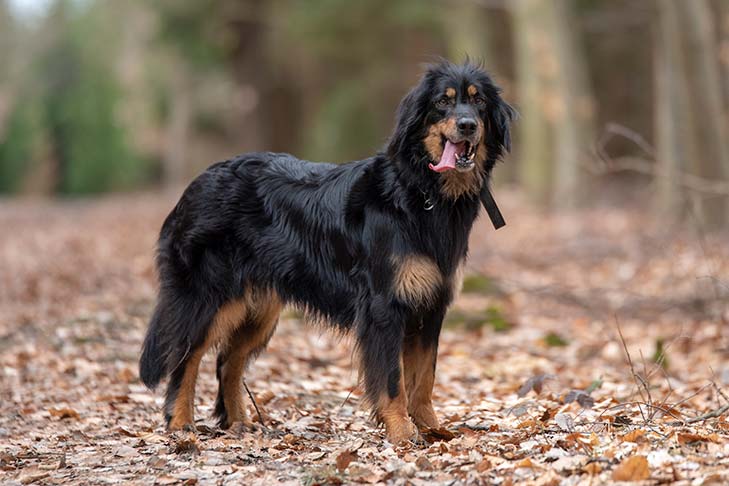
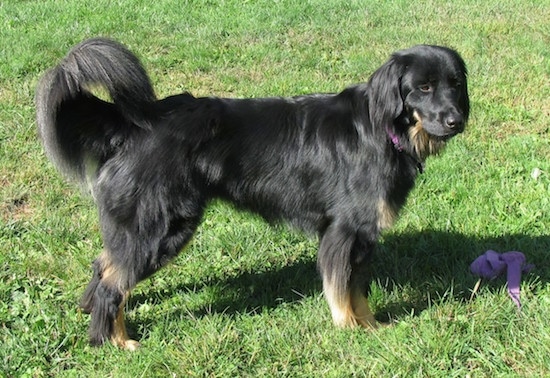
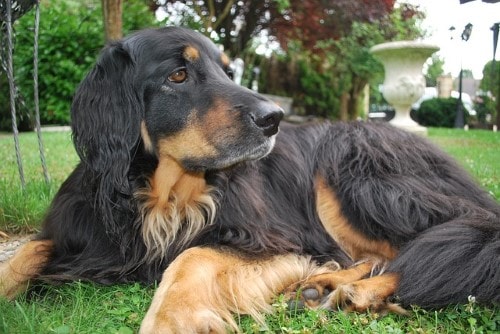
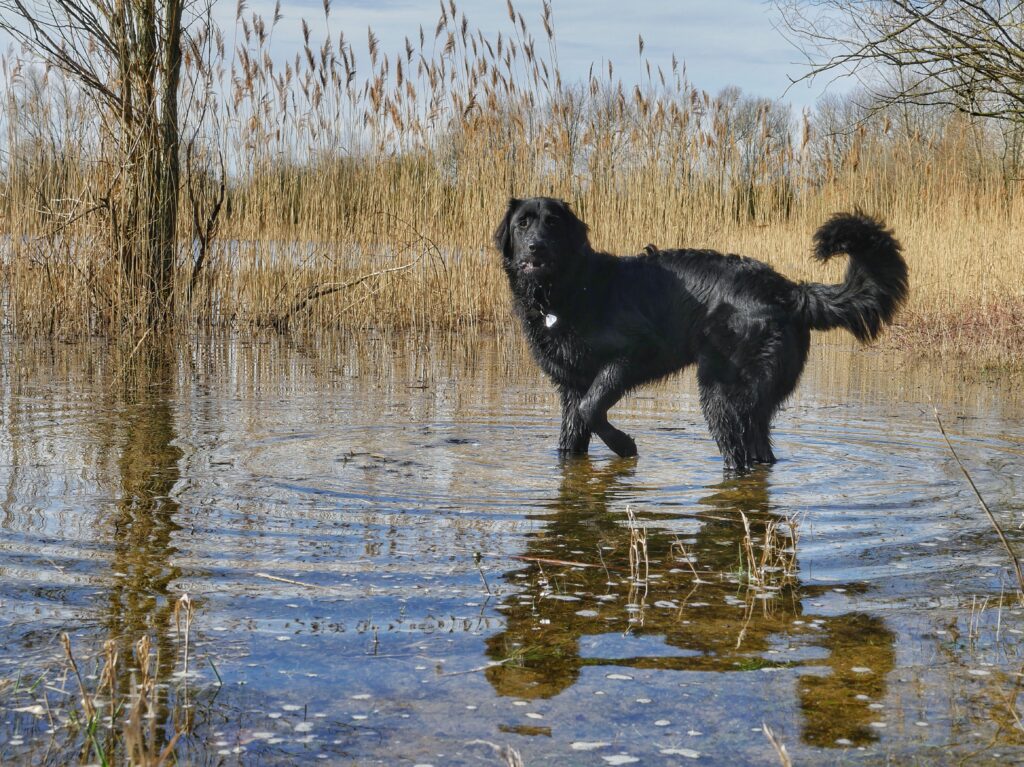
Overview
The Hovawart dog breed has a history of guarding properties and herding animals, shaping them into alert and sturdy companions. These dogs from Germany are known for being both diligent in their duties and loving to their human families. Standing between 23 and 28 inches tall and weighing 65 to 90 pounds, Hovawarts are on the larger side for dogs.
These canines are known for their unwavering loyalty and strong bond with their owners. They are great for families seeking a dog to watch over the home and be close friends. To bring out the best in a Hovawart, they need ongoing, structured training and plenty of activities that keep them mentally and physically busy.
Hovawarts have a dense and lengthy coat that demands much grooming attention, especially when shedding. Owners should be ready to brush them regularly and put in extra grooming effort during these times. With their protective nature and engaging personalities, Hovawarts are ideal for those who value safety and want a devoted pet.
Breed Hallmarks
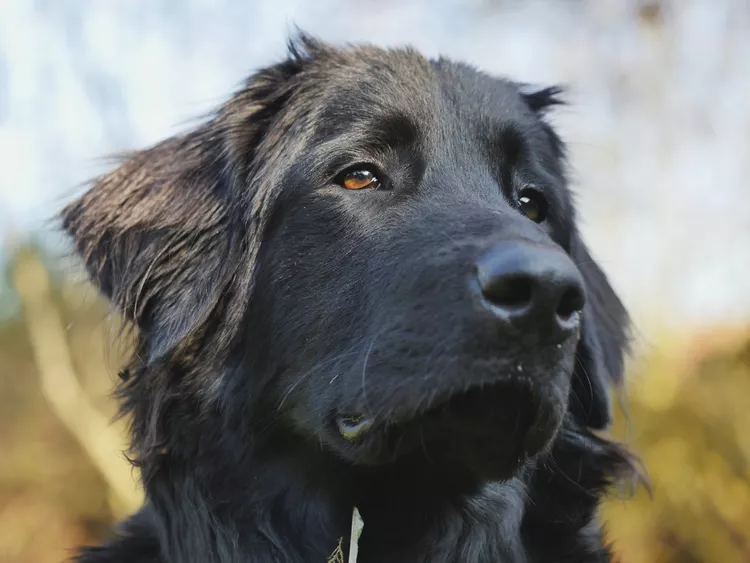
Hovawarts are known for their muscular build and versatile nature, making them standout dogs in various roles, particularly as loyal family guardians and diligent working dogs. They are a medium to large breed, standing between 23 and 28 inches tall and weighing between 65 and 90 pounds, which gives them a robust appearance. Their behavior has been studied and shows they are well-equipped for multiple tasks due to their stable temperament and instinct to protect.
They have a dense, lengthy coat that keeps them warm and protected, which is especially important since they were initially used for outdoor tasks. This coat can be blonde, black, or black with tan or gold accents. The Hovawart’s adaptability and confidence result from careful breeding, including mixing traits from breeds like the Kuvasz and Leonberger to boost their working skills.
Here’s a quick overview of the Hovawart’s essential traits:
| Feature | Description | Relevance |
|---|---|---|
| Size | Medium-large, 65-90 pounds | Fits physical tasks and protection roles |
| Coat | Significant for family life, search operations | Suitable for various climates, unique appearance |
| Temperament | Balanced, vigilant, adaptable | Significant for family life, search operations |
These traits make the Hovawart an excellent choice for those with an active lifestyle or interest in dog sports, where their abilities can shine.
History of the Hovawart
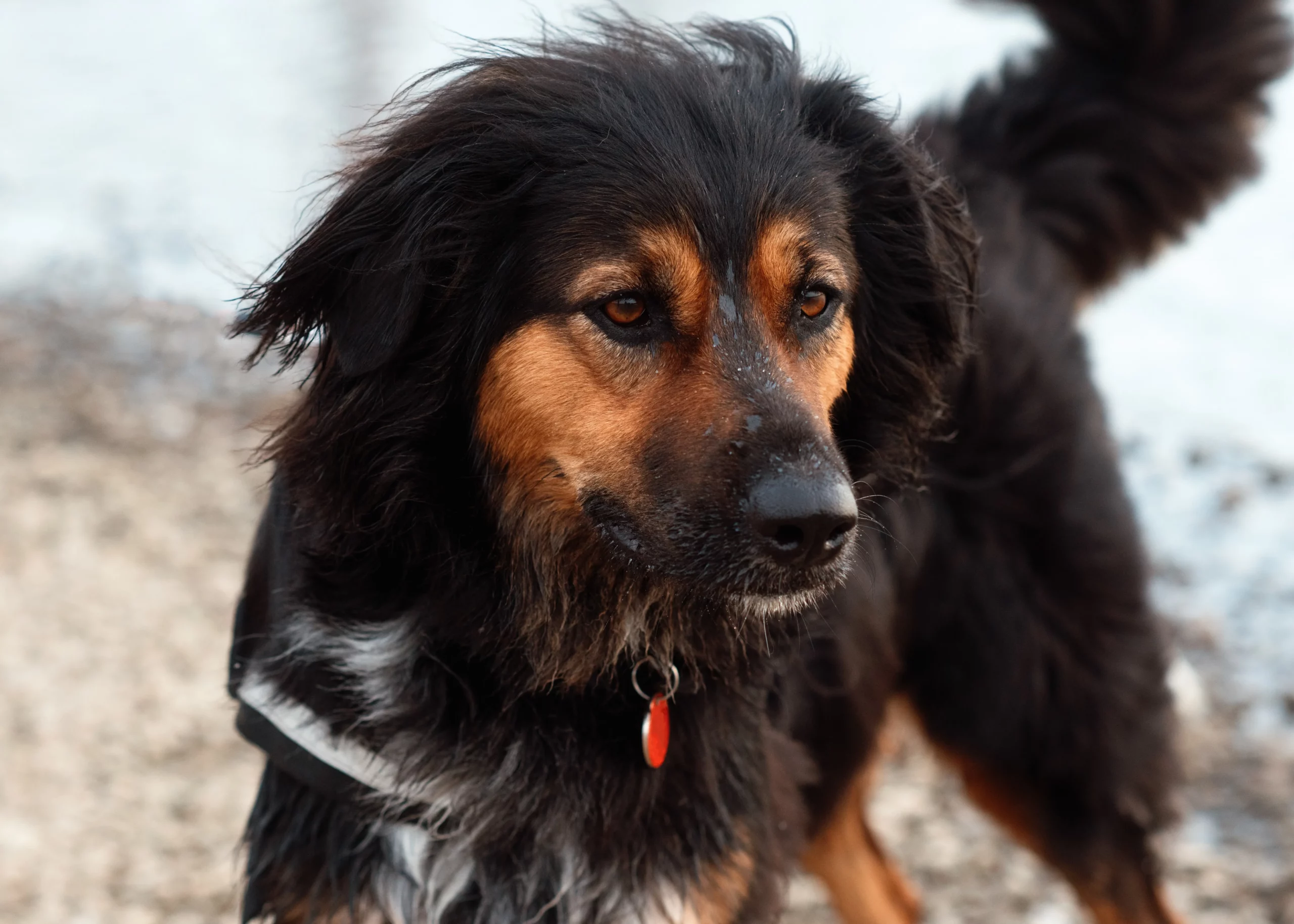
The Hovawart, a dog breed with medieval roots, was initially bred for guard duties, a trait deeply ingrained in their DNA. Their development was marked by careful breeding, focusing on traits necessary for their roles as protectors of estates.
The robust walls of ancient fortresses were once the domain of the watchful Hovawart. These dogs were known for their impressive stature as they kept watch over vast properties and agricultural lands. Careful record-keeping of breeding practices ensured the perpetuation of their guarding solid instincts. Historical records highlight Hovawart’s significant role in the medieval social fabric.
Medieval castles had Hovawarts on patrol, ensuring safety. The dogs’ dominant presence was felt across expansive estates. Breeding logs show efforts to maintain their guarddog abilities. The Hovawart’s role in history is well-documented, showcasing their importance in past societies.
Ancient Guarding Duties
From the medieval era, Hovawarts have been valued for their watchful nature, often tasked with guarding properties and herds. Their name originates from the Middle High German ‘hof’ (farm or estate) and ‘wart’ (guardian), highlighting their role in historical agricultural communities. These dogs were natural at patrolling and defending, crucial in preventing theft and animal attacks. They also had a keen sense of smell, helpful in tracking down missing persons or objects. Breeders were specifically selected for these qualities, ensuring Hovawarts became expert protectors.
Hovawarts played an essential role in medieval society, using their alertness and strength to safeguard homes and animals. Their name comes from the German words for ‘farm’ and ‘watchman,’ showing their job as property protectors. These dogs were experts at keeping watch and fending off threats, vital for people’s safety and livelihoods. Their exceptional noses also made them great at finding things or people who were lost. Breeders worked to keep these protective instincts strong in the Hovawart breed.
Breed Development Period
The Hovawart dog breed has a storied history dating back to medieval times. During this era, breeders focused on improving their natural abilities as guardians for rural communities. They selectively mated dogs from various German breeds known for their protective instincts. This careful breeding played a crucial role in shaping the Hovawart into a dependable and adaptable protector.
However, the breed faced severe risks, especially during the tumultuous times of both World Wars, which disrupted many breeding programs. Despite these obstacles, dedicated breed lovers worked tirelessly to maintain and further develop the breed. Their efforts were successful, ensuring that the Hovawart continued to thrive and evolve.
Notable Historical Roles
During the medieval era, Hovawarts became essential for the security of estates and castles. Known for their loyalty and alertness, these German working dogs were crucial in defending properties from intruders.
After their popularity waned, a revival effort led by zoologist Kurt Friedrich König mixed Hovawarts with breeds like the Kuvasz and Newfoundlands. This breeding program aimed to maintain their guardian instincts.
The breed made a significant comeback when officially recognized by the German Breeding Registry in 1922, marking a pivotal moment in acknowledging their contributions to history. Nowadays, the Hovawart holds the honor of being the seventh working breed in the American Kennel Club (AKC).
They continue to show adaptability in modern tasks such as search and rescue operations and tracking work.
Characteristics of the Hovawart Breed
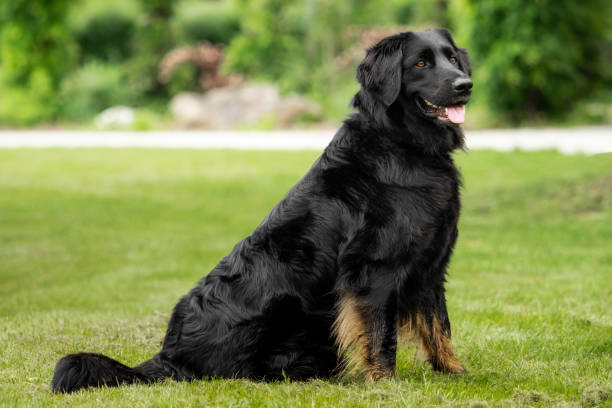
The Hovawart is a sizable dog breed, displaying a range of physical traits that stem from its strong and adaptable heritage. When considering the breed’s stature, it’s essential to consider their living space, dietary needs, and health care.
Here’s a snapshot of what to expect with the Hovawart’s physical characteristics:
Adult Size Variation: Hovawarts come in different sizes, depending on their sex and unique genetic background.
Weight Spectrum: Their varied weight means owners must provide a customized diet and exercise plan.
Height Factors: The height of a Hovawart affects where they can live comfortably, as well as their training and how they interact with others.
Space Needs: Hovawarts thrive in environments with enough room to move and play, which is vital for their well-being.
Typical Adult Size
Adult Hovawarts are notably large dogs. Male Hovawarts typically stand between 25 to 28 inches tall, whereas females usually measure from 23 to 26 inches. Being large is one of the breed’s hallmarks, with their weight ranging from 55 to 110 pounds.
Watching their diet is essential because they can gain weight quickly, affecting their health and mobility. They have a muscular build and a dense, long coat that requires consistent grooming.
Due to their heritage as working dogs, Hovawarts need plenty of physical activity. Owners should ensure these dogs get regular exercise and mental challenges to stay healthy. This activity level helps them keep fit and utilize their natural intelligence and energy.
Weight Range
Hovawart dogs are known for their size, with adult males weighing between 65 and 90 pounds and females being a bit lighter. These dogs are considered significant due to their weight, showing that they were bred to handle tough jobs. Keeping them fit is critical to avoid weight-related health issues and to keep their joints in good shape. These big dogs need to have the right balance of food and exercise to maintain their muscular build and stay healthy.
Proper weight management for a Hovawart is not just about keeping them looking good—it’s about their health. Because they’re big, any extra weight puts more strain on their bones and joints. Regular walks, playtime, and the proper diet are vital for these dogs to keep them in top condition and prevent health problems.
Height Considerations
When evaluating the size of a Hovawart, it’s noteworthy that they generally range from 23 to 28 inches in height at the shoulder. This firmly places them in the large dog breed category.
Their weight varies between 65 and 90 pounds, indicating a muscular build requiring special attention to their living conditions and diet. These dogs need plenty of room to move around to stay healthy and avoid issues related to a lack of exercise.
Their diet must be well-balanced to support their significant size and energy needs. Grooming is another aspect that isn’t overlooked due to their size; regular coat maintenance ensures good hygiene and helps prevent health problems.
Space Requirements
Hovawarts are a large breed with plenty of room to move and stay healthy. These energetic dogs require about two hours of daily exercise to keep fit. They are best suited to homes with a large fenced yard, where they can run and play safely. This is important in both rural and suburban homes.
Their thick coats need regular care, so plan on grooming them a few times a week. They also benefit from advanced training sessions. For this reason, it’s good to have indoor and outdoor spaces set up for grooming and training. This includes having a spot for your dog to dry off after exercise.
A spacious environment also helps to keep these dogs calm, especially since they have strong protective instincts. This can be important if you have young children or lots of visitors. Giving a Hovawart enough physical and mental activity in the right setting is crucial to their happiness.
Growth Patterns
Knowing how to care for giant dog breeds like the Hovawart is vital to their health and growth. These dogs grow slowly but surely, reaching a height of 23-28 inches and a weight of 65-90 pounds after a few years. To help them grow properly, they need the right food and exercise. Keeping an eye on their diet and changing it as they grow is essential. They also need regular exercise to keep their bones and muscles strong. Don’t forget that primary care, like nail trimming, is part of looking after these strong dogs as they grow.
Caring for Hovawart’s growth means paying close attention to their needs. A diet that supports their growth over time is critical to prevent health problems. Their need for calories and nutrients changes as they grow, so adjusting their food is vital. Exercise is just as essential to ensure their bodies are healthy and robust. Regular care, like keeping their nails short, is also part of helping these dogs grow well.
Temperament Traits
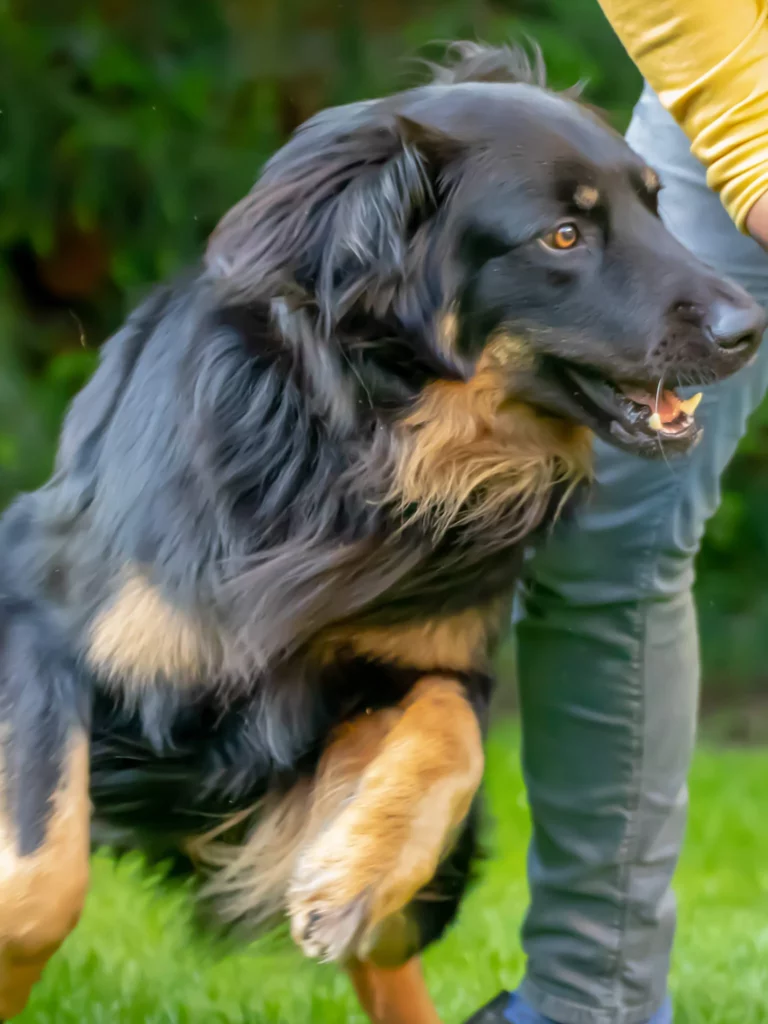
The Hovawart dog breed is known for its dynamic temperament that stems from its genetic makeup and the environment it’s raised in. To truly understand these dogs, we must look at their behavioral characteristics, central to their training and care.
Loyalty and an instinct to guard dog are inherent in Hovawarts, making them alert defenders of their home. Their strong attachment to family showcases their role as faithful pets. They are intelligent dogs with a zeal for learning, making them great candidates for various training activities. However, to prevent any unease around new people, it’s crucial to introduce them to different social situations from a young age.
Understanding these aspects of Hovawart’s personality is critical to meeting their needs and ensuring they are well-adjusted family members.
Loyal Guarding Instincts
Hovawarts are known for their strong instinct to guard and protect their families, showing unwavering loyalty and a protective stance. These large, devoted dogs are excellent watchdogs, naturally inclined to defend their home and loved ones.
They may be wary of new people but are affectionate and kind with children, showing a balanced personality. It’s essential to provide thorough socialization and regular, systematic training to ensure they remain calm and controlled.
A Hovawart does best in a home where they receive discipline, love, and plenty of activities to keep them engaged. They’re best suited for dog owners who have experience and can commit to ongoing training and exercise routines.
Family-Oriented Nature
Hovawart dogs naturally excel at being vigilant protectors and bring a profound sense of loyalty and affection to any family they become a part of.
These dogs are well-suited for family life due to their calm demeanor and loving nature, making them great companions for children.
Yet, they must experience early socialization and consistent training to ensure their protective tendencies don’t become excessive territorial behavior.
The loyal and courageous qualities of Hovawarts, combined with their alertness, don’t just make them loving playmates for kids but also trustworthy guardians for the entire household.
Intelligence and Trainability
Hovawart dogs are known for their keen intelligence and trainability, making them excellent at various tasks, including search and rescue and other work-oriented roles. Their mental sharpness means they’re quick to pick up on training, especially when it’s consistent and structured.
Positive reinforcement works well with Hovawarts, reinforcing good behavior. Since they’re naturally watchful and may be wary of strangers, it’s essential to socialize them early so they grow up to be well-adjusted.
These dogs need both mental and physical challenges regularly. As a result, a training approach that is firm but loving is critical to tapping into their potential and managing their protective nature.
Socialization Requirements
The Hovawart breed is known for its smarts and ease of training, but it’s just as vital to focus on their need for early socialization. Introducing them to various situations, sounds, and people early on is critical to developing a confident and well-adjusted dog. A well-socialized Hovawart will get along better with other animals and be more at ease around people, showing a stable and friendly nature.
To raise a friendly and well-behaved Hovawart, it’s essential to keep exposing them to new experiences. This includes meeting different people and encountering various sights and sounds. Using positive reinforcement, like treats and praise, makes learning to interact nicely more enjoyable for them. It’s also essential to keep up with socialization throughout their lives to maintain their friendly and calm demeanor, which helps them fit in seamlessly with the family and the wider community.
Prey Drive Management
Hovawarts have a strong instinct to chase, which requires careful training to control their agility. Owners should introduce these dogs to various people and situations early on and use rewards-based training to teach them to obey commands like Golden Retriever.
Engaging Hovawarts in tracking and scent work can positively channel their instincts. It’s also beneficial to understand their background as property protectors to effectively manage their desire to chase along with their instinct to guard.
For Hovawarts to thrive, it’s crucial to keep them mentally challenged and physically active, which helps prevent unwanted behaviors linked to their hunting instincts.
Common Health Concerns
Hovawart dogs are sturdy but still face several hereditary health issues requiring careful monitoring and proactive care. Catching these health problems early is critical to lessening their impact and keeping your dog healthy. Knowing the potential health risks and taking the proper steps to care for your Hovawart is essential for their long-term health.
Conducting thorough health screenings and practicing careful breeding to combat genetic health issues is essential. Taking steps to prevent health problems before they arise can significantly decrease the likelihood and severity of these issues in Hovawarts. When symptoms are spotted early, treatment can start quickly, considerably improving the management of any disease that develops. Teaching Hovawart owners about these health risks helps them actively participate in their dog’s health care.
Genetic Health Risks
Hovawart dogs are prone to certain health conditions like hip dysplasia, hypothyroidism, and degenerative myelopathy. These genetic issues can significantly affect the dogs’ well-being and lifespan. Hip dysplasia is of particular concern as it can cause debilitating arthritis and pain. To reduce the incidence of these diseases, breeders must practice selective breeding and perform thorough health tests.
Dog owners should keep up with regular vet visits to catch and address these conditions early. A balanced diet and proper exercise are vital for maintaining the health of Hovawart dogs.
Hip dysplasia, hypothyroidism, and degenerative myelopathy are severe, but with careful attention, their impact can be lessened.
Preventive Care Strategies
Understanding the importance of genetic health risks in Hovawart dogs is essential. We must take preventive care seriously to help these dogs live healthier lives.
Taking your Hovawart for regular veterinary check-ups is critical to catching and managing health issues early on. A nutritious diet suits their age and activity level and keeps them in shape.
Exercise is essential for Hovawarts to stay fit and mentally stimulated. It helps prevent obesity and keeps them happy. Keeping up with their grooming and dental care is also critical to avoid diseases and keep them clean.
To protect future generations, it is essential to follow responsible breeding practices. This helps reduce the chance of passing on genetic problems.
Recognizing Symptoms Early
For Hovawart dog owners, catching health problems early can make a massive difference in treatment and quality of life. Conditions like hip dysplasia, hypothyroidism, and degenerative myelopathy can appear when dogs are young, so it’s essential to watch for signs.
If your dog struggles to get up or seems reluctant to move, these could be signs of hip dysplasia. Unexplained weight gain, lack of energy, and hair loss might signal hypothyroidism.
Degenerative myelopathy often starts with weakness in the back legs and trouble walking. When you groom your Hovawart, check their skin and coat for anything unusual.
Changes in behavior, eating habits, or energy levels could mean it’s time to see the vet. Regular check-ups and attention to your dog’s health can prevent minor issues from becoming big problems.
Hovawart Care: Grooming Essentials
Proper care for a Hovawart’s coat is essential to their overall health. Regular brushing is vital to keep their thick coat in top condition and minimize shedding. They need a careful balance of bathing to keep them clean while protecting their skin’s natural oils. Their paws and teeth and Hovawarts require regular attention to avoid health issues.
- Brushing Schedule: Brushing a couple of times a week helps to keep the coat healthy and reduces hair loss.
- Bathing Guidelines: Bathe your Hovawart only when necessary to avoid stripping their coat of essential oils.
- Trimming Advice: Keep their coat trimmed to a manageable length, especially during the warmer months, to help them stay calm.
- Nail Maintenance: Regularly check and trim their nails to prevent discomfort and potential injury.
Ensuring a Hovawart’s grooming needs are met promotes their well-being. A well-groomed dog is a happy and healthy companion.
Brushing Frequency
For a Hovawart’s coat to stay healthy and look good, it’s best to brush it a few times every week, aiming for at least two or three. Their coats are pretty long and thick, and without regular care, they can easily get tangled or start shedding more than usual. You might need to brush them more often when the seasons change and shedding kicks up a notch. Using the right tools like slicker brushes and combs is critical to removing all that loose fur and keeping their coat in great shape.
Brushing isn’t just about looks – it also keeps their skin healthy and blood flowing correctly. Plus, while grooming, you can spot any skin problems early on. Staying on top of the brushing routine is more than just cosmetic; it’s vital to your dog’s health care.
Bathing Recommendations
Regular bathing, about once every 6 to 8 weeks, is vital to a healthy coat for Hovawart dogs. Choose a gentle dog shampoo that keeps their coat clean while preserving the natural oils that protect their double coat. When washing your Hovawart, rinse the fur thoroughly to avoid skin irritation or dryness.
Consistent brushing between baths is essential to manage the shedding of their long fur and keep it in good condition. After a bath, it’s crucial to dry the coat thoroughly to prevent any skin issues or tangling of their dense fur, ensuring your dog stays happy and healthy.
Coat Trimming Tips
A regular grooming schedule is vital to keeping a Hovawart’s thick, flowing coat in top condition. These dogs have a distinctive coat that needs consistent care. Using the right tools, like a slicker brush and metal comb, makes it easier to untangle knots and clear out matted fur.
Since Hovawarts have nails that increase, it’s essential to trim them often to prevent problems with long nails.
Keeping their ears clean and brushing their teeth should also be routine.
If you’re new to grooming a Hovawart, you might want help from a groomer who knows how to handle their specific coat needs. They can show you how to trim the coat correctly to keep your dog looking and feeling good.
Nail Care Routine
Proper grooming for Hovawart dogs involves paying close attention to their nail care. These robust canines have nails that proliferate and need consistent trimming to avoid discomfort and mobility issues. Early training is critical to getting a Hovawart used to nail trimming, making it a calm part of their routine.
It’s crucial to use the right dog nail clippers and be careful not to cut them quickly, which can cause bleeding and pain. While grooming, looking out for any signs of dirt, debris, or nail damage is essential.
If you’re not confident doing this yourself, seeking professional grooming services is a good option.
Ear Cleaning Guide
Keeping a Hovawart dog’s ears clean is crucial for their well-being and comfort. This breed is prone to ear infections without proper care. To clean their ears, one should use a solution recommended by a vet and carefully wipe the ear’s visible parts. A cotton ball or pad gently removes wax or dirt without harming the ear canal.
Owners should always look for signs of infection, like redness, discharge, or bad smells. If you notice any of these, it’s time to see the vet. Making ear cleaning a positive experience for your dog can help make it a routine part of their care.
Ensuring good ear hygiene is a necessary part of owning a Hovawart. Regular ear checks and cleaning can prevent painful infections and keep your dog happy. Use a vet-approved ear-cleaning solution and a soft cotton ball or pad to clean the reachable parts of your dog’s ears. Watch out for redness, unusual discharge, or foul odors, which can indicate an infection. If you spot these signs, take your dog to the vet promptly.
Nutritional Requirements
Feeding Hovawart dogs requires careful planning to meet their unique health needs and ensure they stay active and healthy. Balancing their diet with the right mix of proteins, fats, and carbohydrates is crucial to match their high energy levels.
A diet tailored for Hovawarts should adjust to their life stages, providing the proper nutrients for puppies, adult dogs, and seniors. It’s also important to watch for signs of food allergies and address them promptly. Monitoring their food intake is necessary to maintain their varying activity levels.
When creating a feeding routine for a Hovawart, consider consulting with a vet to ensure their dietary needs are met. This helps prevent overfeeding and obesity, which can lead to health issues. Regular vet visits will also help adjust their diet or lifestyle changes as they age.
Balanced Diet Essentials
To ensure your Hovawart dog stays healthy, include a mix of critical nutrients in their diet. This means choosing high-quality proteins from meats like chicken, turkey, or fish to keep their muscles strong. Including healthy fats rich in omega-3 fatty acids is also crucial, as they keep the dog’s coat shiny and support brain health. Carbohydrates should come from sources like whole grains and vegetables to provide the energy these family dogs need.
Vitamins and minerals are vital in strengthening the immune system and maintaining bone health. To avoid obesity, it’s also important to watch how much food your household eats. Always have fresh water available to aid digestion and the absorption of these nutrients.
These steps are critical to a balanced diet for your hovawart’s health and happiness.
Age-Specific Nutrition
A balanced diet is vital to maintaining a healthy heart at every stage of its life. Puppies, adults, and senior dogs all need different nutrients to thrive.
For growing Hovawart puppies, a protein-rich diet is vital for building strong muscles and bones. They also need plenty of fats, vitamins, and minerals to support their developing immune systems.
As they grow into adulthood, Hovawarts need food that helps them maintain a healthy weight and meets their energy needs for regular activity.
Older Hovawarts benefit from lower-calorie diets that are still nutrient-dense, focusing on ingredients that support digestive health and joint maintenance.
Food Allergies Management
For Hovawart dogs with food allergies, they manage their diet carefully. This involves recognizing and excluding any foods that might cause an allergic reaction. Ingredients such as beef, dairy, wheat, and soy are often problematic.
Dogs with allergies benefit from hypoallergenic dog food that reduces allergic reactions while providing all the necessary nutrients.
Working with a vet is essential to run food trials to determine exactly what causes allergies in your heart. Adding supplements like omega-3 fatty acids and probiotics can improve skin and gut health, commonly affected by food allergies.
Keeping a detailed food journal helps track what your Hovawart eats and any allergic reactions, ensuring you can manage their allergies effectively and keep them comfortable.
